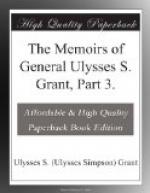Near the point selected by Bowen to defend, the road to Port Gibson divides, taking two ridges which do not diverge more than a mile or two at the widest point. These roads unite just outside the town. This made it necessary for McClernand to divide his force. It was not only divided, but it was separated by a deep ravine of the character above described. One flank could not reinforce the other except by marching back to the junction of the roads. McClernand put the divisions of Hovey, Carr and A. J. Smith upon the right-hand branch and Osterhaus on the left. I was on the field by ten A.M., and inspected both flanks in person. On the right the enemy, if not being pressed back, was at least not repulsing our advance. On the left, however, Osterhaus was not faring so well. He had been repulsed with some loss. As soon as the road could be cleared of McClernand’s troops I ordered up McPherson, who was close upon the rear of the 13th corps, with two brigades of Logan’s division. This was about noon. I ordered him to send one brigade (General John E. Smith’s was selected) to support Osterhaus, and to move to the left and flank the enemy out of his position. This movement carried the brigade over a deep ravine to a third ridge and, when Smith’s troops were seen well through the ravine, Osterhaus was directed to renew his front attack. It was successful and unattended by heavy loss. The enemy was sent in full retreat on their right, and their left followed before sunset. While the movement to our left was going on, McClernand, who was with his right flank, sent me frequent requests for reinforcements, although the force with him was not being pressed. I had been upon the ground and knew it did not admit of his engaging all the men he had. We followed up our victory until night overtook us about two miles from Port Gibson; then the troops went into bivouac for the night.
CHAPTER XXXIV.
Capture of port Gibson—GRIERSON’S raid—occupation of Grand Gulf —movement up the Big black—battle of Raymond.
We started next morning for Port Gibson as soon as it was light enough to see the road. We were soon in the town, and I was delighted to find that the enemy had not stopped to contest our crossing further at the bridge, which he had burned. The troops were set to work at once to construct a bridge across the South Fork of the Bayou Pierre. At this time the water was high and the current rapid. What might be called a raft-bridge was soon constructed from material obtained from wooden buildings, stables, fences, etc., which sufficed for carrying the whole army over safely. Colonel J. H. Wilson, a member of my staff, planned and superintended the construction of this bridge, going into the water and working as hard as any one engaged. Officers




